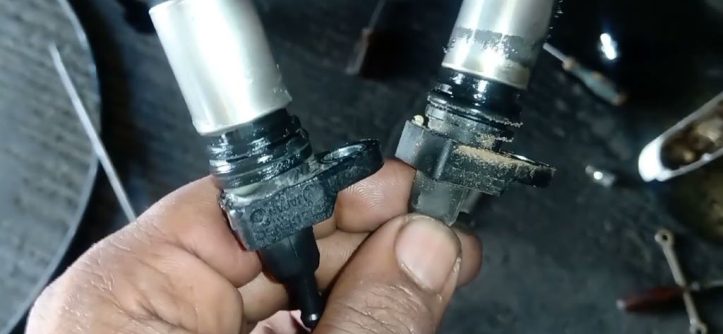Imagine you’re all set for a road trip, excited and ready to hit the open road, only to find out that your car won’t start. It’s a frustrating situation that can happen to anyone, and one of the culprits behind this issue could be a malfunctioning crankshaft position sensor. But fear not! In this comprehensive guide, we’ll walk you through the steps to reset your crankshaft position sensor and get your car back on the road.
What is a Crankshaft Position Sensor?
Before we dive into the nitty-gritty of resetting a crankshaft position sensor, let’s first understand what it is and why it’s essential. Think of the crankshaft position sensor as the “eyes” of your car’s engine. It monitors the position and rotation speed of the crankshaft, sending this information to the engine control unit (ECU). The ECU uses this data to control the ignition timing and fuel injection, ensuring your engine runs smoothly.
When the crankshaft position sensor malfunctions or loses calibration, it can cause a host of issues, including a no-start condition. That’s when you’ll need to reset it. So, let’s get started.
Step 1: Safety First
Before we delve into resetting the crankshaft position sensor, ensure your safety and the safety of others. Park your car in a safe location, away from traffic, and engage the parking brake. Pop the hood and disconnect the negative terminal of the battery to prevent any electrical mishaps.
Step 2: Locate the Sensor
The next step is to find the crankshaft position sensor in your vehicle. The sensor’s location can vary depending on the make and model of your car, so consult your owner’s manual or do a quick online search to pinpoint its exact location. Typically, it’s somewhere near the engine’s crankshaft or camshaft.
Step 3: Remove the Sensor
Once you’ve located the sensor, you’ll need to remove it. This may require some tools, such as a wrench or socket set. Carefully disconnect the electrical connector and then remove the sensor from its mounting bracket. Be gentle to avoid damaging the sensor or any surrounding components.
Step 4: Inspect for Damage
Before proceeding further, take a close look at the sensor for any signs of damage or wear. If you notice any cracks, frayed wires, or other issues, it’s a good idea to replace the sensor entirely. Resetting a damaged sensor won’t solve the problem.
Step 5: Clean the Sensor
Assuming the sensor appears to be in good condition, it’s time to clean it. Over time, the sensor can accumulate dirt, oil, or debris, which can interfere with its operation. Use a clean cloth or a suitable cleaning agent to gently wipe away any grime.
Step 6: Reset the Sensor
Now, here’s the crucial part – resetting the crankshaft position sensor. There are two primary methods to do this: the manual method and the use of an OBD-II scanner.
Manual Reset Method:
- Reinstall the sensor back into its mounting bracket.
- Reconnect the electrical connector securely.
- Reconnect the negative terminal of the battery.
- Start your car and let it idle for a few minutes.
- Take it for a test drive to ensure the sensor is functioning correctly.
Using an OBD-II Scanner:
- Plug the OBD-II scanner into the diagnostic port under your car’s dashboard.
- Turn on the ignition without starting the engine.
- Follow the scanner’s instructions to access the ECU and locate the crankshaft position sensor reset option.
- Select the reset option and follow any on-screen prompts.
- Once the reset is complete, start your car and check if the issue is resolved.
Step 7: Test Drive
After resetting the crankshaft position sensor, it’s essential to take your car for a test drive to confirm that the problem has been resolved. Pay attention to how the engine performs – if it starts smoothly and runs without any issues, you’re on the right track.
FAQs
What are the signs of a malfunctioning crankshaft position sensor?
A malfunctioning crankshaft position sensor can lead to symptoms like a no-start condition, intermittent stalling, poor engine performance, and difficulty starting your car.
How often should I reset my crankshaft position sensor?
You should only reset your crankshaft position sensor when it is malfunctioning or has lost calibration. It’s not a routine maintenance task.
Can I reset the crankshaft position sensor on my own, or do I need a mechanic?
You can reset the crankshaft position sensor on your own if you have the necessary tools and follow the steps outlined in this guide. However, if you’re not comfortable doing it yourself, it’s always a good idea to consult a mechanic.
What if resetting the crankshaft position sensor doesn’t solve the problem?
If resetting the sensor doesn’t resolve the issue, it’s possible that the sensor itself is faulty and needs replacement. Consult a mechanic for a more in-depth diagnosis.
Are there any preventive measures to avoid crankshaft position sensor issues?
While you can’t prevent sensor failures entirely, regular maintenance, such as keeping your engine clean and checking for damaged wires or connectors, can help prolong the sensor’s life.
Conclusion
A malfunctioning crankshaft position sensor can throw a wrench in your plans, but resetting it can often get your car back on track. Remember to prioritize safety when working on your vehicle and follow the steps outlined in this guide. The benefits of servicing your vehicle extend beyond routine maintenance; it ensures optimal performance, longevity, and safety. If you encounter any issues or are uncomfortable with the process, don’t hesitate to seek professional help from a mechanic. With a little patience and know-how, you’ll be back on the road in no time, enjoying the smooth purr of your engine once again.
Tags: auto diagnostics, automotive advice, automotive mechanics, automotive repair, automotive technology, car maintenance, car repair, car troubleshooting, car won't start, crankshaft position sensor, DIY auto repair, engine problems, engine sensors, no start condition, sensor reset, starting issues, troubleshooting tips, vehicle diagnostics, vehicle maintenance, vehicle troubleshooting





Leave a Reply